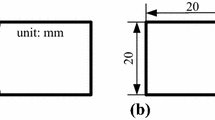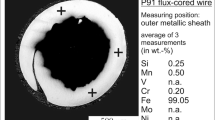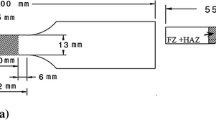Abstract
This study observed the cold crack susceptibility of three types of low-hydrogen flux-cored arc (FCA)-weld metals developed for a yield strength of 600 MPa. Cold cracks in the weld metal were measured using the Y-groove test, and four different preheating temperatures were employed from room temperature to 150 °C. The microstructure of the Y-groove weldment consisted of acicular ferrite, bainite, and martensite. All weld metals showed cold cracking at room temperature, and a preheating temperature of 50 °C produced cold cracking only for weld metal C, having the largest carbon equivalent and the largest volume fraction of bainite and martensite. The volume expansion ratio of the weld metals was measured when the austenite was transformed to martensite during simulated weld cooling. Weld metal C showed the largest volume expansion ratio (2.6 %), resulting in the largest probability of cold crack production. Moreover, the martensite affected the cold crack fractography in the weld metal. Intergranular fracture occurred in the region occupied by large volume fractions of martensite, and quasi-cleavage fracture was observed in regions of small-volume fractions of martensite. Large amounts of martensite were related to the regions of high Mn content and corresponding to intergranular fracture.








Similar content being viewed by others
References
Kitada T, Fukuda K (1986) Nippon Kokan Technical Report. 47:58-64
Fisher JW, Dexter RJ (1994) High-performance steels for America’s bridges. Weld J 73(1):35–43
Parmar RS (ed) (1999) Welding processes and technology. Khanna Publishers, New Delhi, pp 53–61
Davidson JL (1998) Advances in hydrogen management: the science based design of Low hydrogen consumables for the future. Australas Weld J 43(3):33–39
Kuebler R, Pitrun M, Pitrun I (2000) The effect of welding parameters and hydrogen levels on the weldability of high strength Q&T steel welded with FCAW consumables. Australas Weld J 45(1):38–47
Kou S (1987) Welding metallurgy. John Wiley and Sons, New York
Easterling K (1983) Introduction to the physical metallurgy of welding. Butter-worths & Co Ltd
Wildash C, Cochrane RC, Gee R, Widgery DJ (1998) Microstructural factors affecting hydrogen induced cold cracking in high strength steel weld metals. Trends in Welding Research, Georgia, USA
Lee HW, Kang SW, Um DS (1998) A study on transverse weld crack in thick steel plate with FCAW process. Weld J 77(12):503–510
White D, Pollad G, Gee R (1992) The effect of welding parameters on diffusible hydrogen levels in cored wire welding. Weld Met Fabr 60(6):209–216
Dixon B, Hakansson K (1995) Effects of welding parameters on weld zone toughness and hardness in 600 MPa steel. Weld J 74(4):122–132
Kiefer JH (1996) Effects of moisture contamination and welding parameters on diffusible hydrogen. Weld J 75(5):155–161
Harwig DD, Longenecker DP, Cruz JH (1999) Effects of welding parameters and electrode atmospheric exposure on the diffusible hydrogen content of gas shielded flux cored welding. Weld J 78(9):314–321
Pitrun M, Davidson JL, Kenny CJ, Wittke PJ, Cornish N (2001) Factors affecting the hydrogen content of weld metal deposited by flux cored arc welding consumables. Australas Weld J 46(1):33–38
Pitrun M, Nolan D (2006) Susceptibility of low strength rutile flux-cored weld metal to hydrogen assisted cold cracking. Weld World 50(5/6):24–37
Enzinger N, Cerjak H (2007) Characterization of cracks in high strength steel weldments. Weld World 51(11/12):29–33
Sierdzinski MS, Ferree SE (1998) New flux core wires control diffusible hydrogen levels. Weld J 77(2):45–48
Marchenko AE (1995) Development of technology for producing low-hydrogen electrode. Weld Int 9(1):51–55
Matsushida M, Liu S (2000) Hydrogen control in steel weld metal by means of fluoride addition in welding flux. Weld J 79(10):295–303
Hart PHM (1986) Resistance to hydrogen cracking in steel weld metal. Weld J 65(1):14–22
Lee HW (2007) Weld metal hydrogen-assisted cracking in thick steel plate weldments. Mater Sci Eng A 445–446:328–335
Seo JS, Kim HJ, Ryoo HS (2008) Effect of grain boundary ferrite on susceptibility to cold cracking in high-strength weld metal. Met Mater Int 14(4):515–522
Kim JH, Kim JS, Ryoo HS, Kim KH, Huh MY (2008) Effect of weld metal microstructures on cold crack susceptibility of FCAW weld metal. Met Mater Int 14(2):239–245
IIW/IIS DOC. 452-74. (1974) Welding in the World 12(3/4):65-69
AWS A 4.3. (1993) American Welding Society
ISO 17642-2 (2005) Destructive tests on welds in metallic materials—cold cracking tests for weldments—arc welding processes part 2. Self-restraint tests
Kannengiesser T, Boellinghaus T (2013) Cold cracking tests—an overview of present technologies and applications. Weld World 57:3–37
Seo JS, Kim HS, Ryoo HS (2008) Microstructural parameter controlling weld metal cold cracking. JAMME 27(2):199–202
Lee JH, Kim SH, Yoon BH, Kim HT, Kil SC, Lee CH (2011) Microstructural characteristics of 800 MPa grade high strength steel weld metals. J KWJS 29(1):65–73 (in Korean)
Garland JR, Kirkwood PR (1975) Toward improved submerged arc weld metals. Metal Constr Part 1 7(5):275–283
Garland JR, Kirkwood PR (1975) Toward improved submerged arc weld metals. Metal Constr Part 2 7(6):320–330
Lee MJ, Kang NH (2014) The effects of microstructure on cold crack in high-strength weld metals. J KWJS 32(1):22–27 (in Korean)
Bhadeshia H and Honeycombe R (2011) Steels: microstructure and properties. Butterworth-Heinemann
Wang W, Huo L, Zhang Y, Wang D, Jing H (2002) New developed welding electrode for improving the fatigue strength of welded joints. J Mater Sci Technol 18:527–531
Murata H, Kato N, Tamura H (1993) Effect of transformation on residual stress in welding. Yosetsu Gakkai Ronbunshu/Q J Japn Weld Soc 11:545–50
Pargeter RJ (1992) Effects of arc energy, plate thickness and preheat on C-Mn steel weld metal hydrogen cracking. TWI report No. 461/1992, TWI, Abington Cambridge, UK
Seo JS, Kim JH, Kim HJ, Ryoo HS (2007) Characteristics of cold cracks in FCA weld metal. J KWJS 25(4):242–346 (in Korean)
Shibata A, Yonezawa H, Yabuuchi K, Morito S, Furuhara T, Makia T (2006) Relation between martensite morphology and volume change accompanying fcc to bcc martensitic transformation in Fe–Ni–Co alloys. Mater Sci Eng A 438–440:241–245
Acknowledgments
This work was financially supported by the Ministry of Trade, Industry and Energy (no. 10035163) and the National Research Foundation of Korea (NRF) grant funded by the Korea government (MSIP) through GCRC-SOP (no. 2011-0030013).
Author information
Authors and Affiliations
Corresponding author
Additional information
Doc. IIW-2552, recommended for publication by Commission II “Arc Welding and Filler Metals”.
Rights and permissions
About this article
Cite this article
Lee, M., Cho, K., Kim, Y. et al. Effect of martensite on cold cracking in 600-MPa grade flux-cored arc weld metals using the Y-groove test. Weld World 59, 647–654 (2015). https://doi.org/10.1007/s40194-015-0240-5
Received:
Accepted:
Published:
Issue Date:
DOI: https://doi.org/10.1007/s40194-015-0240-5




